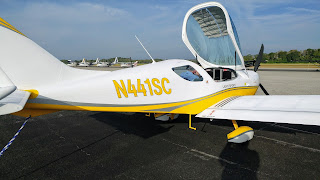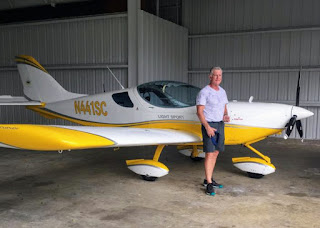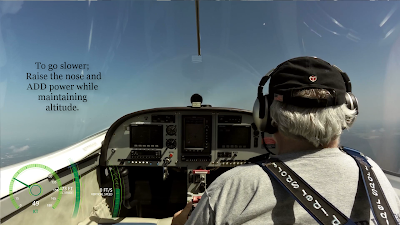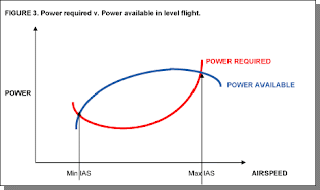But the weather window did finally open up. I flew United into O'Hare, John met me with the big ugly Suburban and we drove over to General Mitchel International to get Todd, then waited for a later flight to get Paul. We had dinner, made some plans and decided to get up before the crack of dawn to start flying his airplane home. Along the way I would act as safety pilot and provide some instruction on the SportCruiser.
Thursday September 28th.
 |
| The way home. |
When the dawn came we were climbing into the plane. 0720 CDT, we took off into the sunrise and headed south. I was glad to find that Paul had a nice touch for the airplane already, gently holding the stick and punching the buttons for the electric trim as we headed toward Chicago. We climbed to 7500ft and found smooth air and...a tailwind. Just a few knots, but still helping us move along. Wow.
First stop was Mount Vernon, Illinois, a nice airport and very friendly FBO. They host the Midwest LSA show and always welcome Light Sport Airplanes. We listened to the CTAF chatter as we approached counting at least three other airplanes in the pattern. The GPS said we coming up quickly but no field in sight. Ten miles, five miles, oops, right in front of us. How did that happen? Still 1000ft above pattern altitude we circled out to come back in,which forced us to be high and fast. Paul handled it well. Once he got slow enough to drop the flaps, he made the base turn, then when on final applied a slip. Round out and flare led to a nice landing. A great salvage to a horrible entry. We asked to top off the tanks, made a quick rest stop and got airborne again at 10:30 CDT.
The next stop was Auburn, Alabama, home of the War Eagle, the Plainsmen and Aubie the Tiger. This trip would take us through the controlled airspace (MOA) of Fort Campbell, the home to the only Air Assault Division in the world. The Dynon system gave us an alert that the MOA was hot and highlighted the airspace in orange. Soon after the controller asked us if we wanted to proceed east or west around the restricted airspace. Paul decided to go west and we were given a heading to stay clear. (Pushed the button to change the autopilot to Heading mode and adjusted 10° right. Just that easy.) Once clear of the airspace we were handed back to Memphis Center, and eventually over to Atlanta. As we approached Auburn we started to see a lot of "black dots" on the Dynon SkyView display. The controller told us "multiple targets, squawk VFR, frequency change approved" and let us fight it out for ourselves. I think there were probably 6-10 "dots" in the pattern with more on the entry. We picked out one on downwind and Paul followed him around. He landed a bit long, but got us off at the right exit and promptly cleared the runway. Nice job. We asked to top off the tanks, made a quick rest stop and got airborne again at 2:25 CDT.
 |
| Preflighting a new airplane. |
Friday September 29th
I met Paul at the hotel and drove him to the airport. We did some preflight planning and found the weather was "marginal". A tropical disturbance in the Florida straights was sending crud (meteorological term) up into southern Florida. But we both decided that it was worth a "look see" and he departed about 10:00EDT heading south. I would get a text message later that he had diverted into Stuart (KSUA) to wait out some of the bad parts of the storm. (Good headwork.) He got his airplane home to Pompano (KPMP) by 1:00EDT.
What an Excellent learning experience!
So, we had a lot of time in a cockpit together. We talked about a lot of things, mostly aviation. We avoided politics. I'm delighted to have a new friend.
 |
| Not Sally. |





